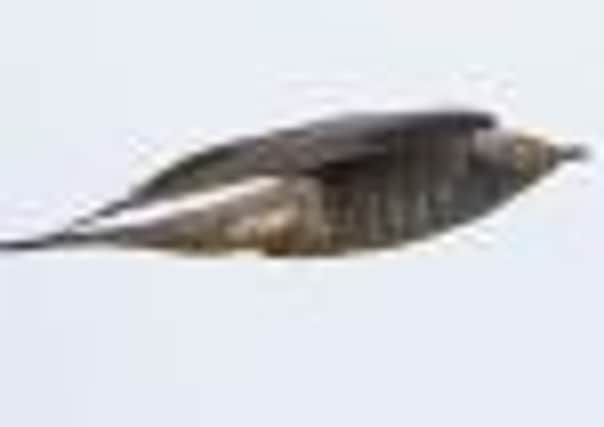Birdwatch: Technology on the track of the cuckoo


The cuckoo sings in May,
The cuckoo sings in part of June,
And then he flies away
This traditional rhyme is part of the large body of folklore about the cuckoo and its association with spring.
But this year, with June almost over, cuckoos are still singing across the region with up to five heard this week at the RSPB’s Fairburn Ings reserve, near Castleford.
Advertisement
Hide AdAdvertisement
Hide AdPerhaps the early start to the breeding season this spring has enabled more birds to try for second broods, in turn providing cuckoos with more opportunities.
It is the male cuckoo who sings the familiar song; the female makes a quite different quiet gurgling noise, not often heard or recognised.
She lays up to 25 eggs, with the reed warbler, meadow pipit and dunnock being the three main hosts – the Fairburn Ings birds choose reed warblers.
These three species account for 80 per cent of all recorded breeding attempts by cuckoos, with reed warbler increasing in importance over the last 60 years as meadow pipit and dunnock numbers have diminished.
Advertisement
Hide AdAdvertisement
Hide AdEach female lays her eggs in the nests of the species which raised her, and she is able to produce eggs that in appearance closely mimic those of her host.
So cuckoos that specialise in reed warblers lay greenish spotted eggs while those that prey on meadow pipits lay mottled brown eggs.
Just how a large female cuckoo manages to lay her eggs in the nests of such small hosts was once a matter of considerable debate among members of the British Trust for Ornithology.
Eventually, it was proved that the female cuckoo is capable of literally squirting her egg directly into the smallest of nests in a matter of seconds, after removing one of the host’s eggs.
Advertisement
Hide AdAdvertisement
Hide AdScience has moved on since those early debates and, as previously reported in the Yorkshire Post, the BTO has now harnessed space-age technology to track the whereabouts of five cuckoos, which were trapped in Norfolk and fitted with tiny tracking devices costing £2,500 each.
Three of the cuckoos have already left Britain, with one near the south coast of France this week, another in scrubland in the centre of Antwerp docks and the third in a narrow strip of the Netherlands bordered by Belgium and France.
Chris Hewson, one of the BTO staff involved in the project, said that the three are all one-year-old birds that might have found mating opportunities limited.
Although this research is expensive it will, hopefully, answer some of the questions as to why cuckoos have declined by 65 per cent in this country since the mid-1980s and are now red listed by the BTO as a bird of conservation concern.
Advertisement
Hide AdAdvertisement
Hide AdChris said that, at present, there is no clear idea of what is causing the decline but, given the fact that so many birds that winter in Africa are showing similar falls in numbers, it was important to investigate the possibility that conditions on the wintering grounds are a factor.
The five cuckoos are being sponsored – see www.bto.org/cuckoosfor more details if you would like to contribute.
Another stone curlew has been seen in the region, following the one on May 5 at the Old Moor reserve, South Yorkshire. The latest one was first seen near the North Marsh, at Flamborough, on Saturday afternoon, and remained the following day.
Three first-summer Mediterranean gulls were seen at the North Cave Wetlands reserve, East Yorkshire; a pair have produced young at the Potteric Carr reserve, near Doncaster, and a pair are still at the Old Moor reserve, South Yorkshire, where a third bird, one of last year’s brood, was seen last week.
Quail are still calling in many areas with at least 17 heard in fields around Kirklevington, Cleveland, on Sunday.